|

 I
arrived on Bokissa Island, six miles off Espiritu Santo, in 1988 from Tokyo, six months after my husband, Kevin, arrived here from Australia.
I had no knowledge of the country, no management experience, and knew only
a few words of English. I lived on the island for six years, operated a
SCUBA diving business called Bokissa Island Dive, ran Bokissa Island Resort
for a few years, then moved to Luganville town on Espiritu Santo Island
- to begin the dive company, “Aquamarine”. I
arrived on Bokissa Island, six miles off Espiritu Santo, in 1988 from Tokyo, six months after my husband, Kevin, arrived here from Australia.
I had no knowledge of the country, no management experience, and knew only
a few words of English. I lived on the island for six years, operated a
SCUBA diving business called Bokissa Island Dive, ran Bokissa Island Resort
for a few years, then moved to Luganville town on Espiritu Santo Island
- to begin the dive company, “Aquamarine”.
Back then,
I thought people would go mad living on a tiny island, where the pace
of life is permanently set on slow motion. But the longer I stayed, the
more I learnt about the people, their culture, the nature and timelessness
of the island itself. Six years of life on small island taught me to speak
Bislama (the indigenous Vanuatu language), to work with ni-Vanuatu people,
to deal with cyclones and earthquakes, and it also taught me endless patience
and an appreciation of something far more important than the reckless
pace of the modern world.
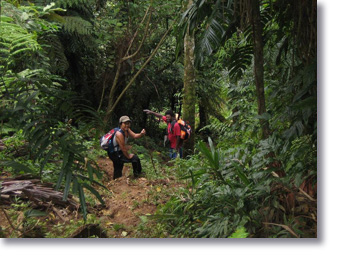
In
2005, Inspired by Santo's explorer Glen Russel's story about Pygmies and Lysepsep people who live in the jungle of Vanuatu. I started trekking into the jungle, to places few Europeans have
ever seen. I visited remote villages in South Santo inhabited by people
still steeped in five thousand year old traditions, and my heart was captured
by the sheer majesty of this landscape and the extraordinary people who
live here, until my spirit became part of this land, and part of these
people.
I am here
to introduce you to the fascinating Melanesian people, the majestic island
of Espiritu Santo, and to share with you the other amazing islands that
make up this unique South Pacific paradise known as Vanuatu.
-
Mayumi Green
A
DEEP BUSH ADVENTURE TO MARAKAI VILLAGE, SOUTH SANTO
At the end
of August 2006, Mayumi and Yumi Takei (a JOCV
volunteer at College de Luganville, Santo) completed a successful hike
through the tropical jungle of South Santo to a very remote Custom village
called "Marakai". Mayumi had made a shorter trip to Marakai
(along with Dr Jo Bell, former vet of Luganville) in November 2005 and
was so fascinated by the beauty of tropical jungle and the bush people
of South Santo, she could not wait to visit Marakai once more.
Mayumi
and Yumi’s adventure to Marakai included a 5 night and 6 day hike through
Marakai - Tanmet - Vunaspef. The following story and photograph has been
supplied by Mayumi Green in the hope of inspiring others to visit the
more remote and far-away villages of South Santo.
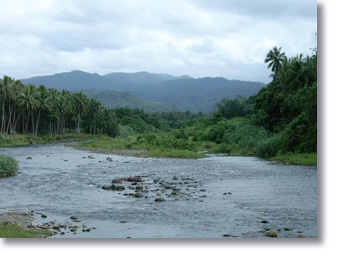 Day
1: Myself, Yumi, our friend Samuel from Vunaspef and Andy from
Tanmet (both sons of the Chief of the village) drove to Namoru village
in South Santo. There we picked up Thomas and Alexi who where to be our
guides to hike us through to Marakai. Samuel and Alexi guided my first
trip to Marakai, so I was feeling very comfortable with the crew. Day
1: Myself, Yumi, our friend Samuel from Vunaspef and Andy from
Tanmet (both sons of the Chief of the village) drove to Namoru village
in South Santo. There we picked up Thomas and Alexi who where to be our
guides to hike us through to Marakai. Samuel and Alexi guided my first
trip to Marakai, so I was feeling very comfortable with the crew.
We left Namoru
village at 10.00 am. Villagers provided their advice of
the planned hike and we then left the 4WD behind at Melesule
and hiked to Malatao village at Wylapa River. We arrived at Supemalao
village (823 feet above sea level) at 1.00 pm for a short rest.
While
there we met our friend Baba the Nambut (means deaf) and then continued
our hike passing Jalakatui village (1,000 feet), and reached Marukari
village (1,330 feet) around 2.30 pm. We reached Tabunbotari village (1,154
feet) at 5.00 pm to stay for our first night.
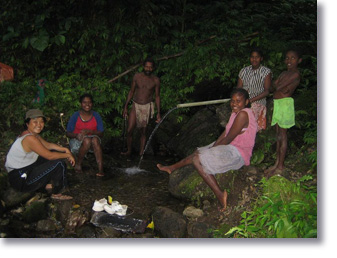 This was
the same village I had previously stayed at. Last time there was only
three adults in the village, but this second time around there was about 50
people in the village and large numbers of pikinini (children), who were
back for school holidays and having a lafet (party or celebration) and
great time with their families and friends. This was
the same village I had previously stayed at. Last time there was only
three adults in the village, but this second time around there was about 50
people in the village and large numbers of pikinini (children), who were
back for school holidays and having a lafet (party or celebration) and
great time with their families and friends.
The boys were playing soccer
with a ball made from the Black Palm tree, the ball only survived 5 minutes
so they just kept on making more as needed. Only people living in remote
areas could invent like this.
We bathed in the nearby river with other
girls and then we were treated to a kava welcoming ceremony by Johnbos
and family, followed by great kaikai (food). That night we slept with
15 other people inside a Nakamal (community bungalow). Inside the Nakamal,
the floor was dirt and we slept in sleeping bag on mats made from leaves.
Between the mats, there were small fires to keep us warm during the night.
The people know how to make a good fire last through the night.
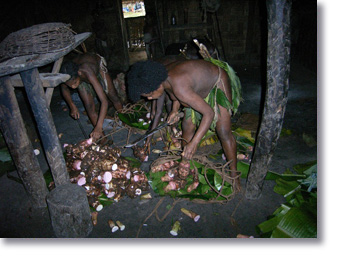 Day
2: After breakfast of taro, we left Tabunbotari for our first
destination and arrived at 10.30 am at Danis (1,573 feet). There was an
abandoned and derelict house we name the “snake house” because
we had found a big snake living in the house on the previous trip. We
could see Araki Island far into the distance. We walked down to Wylapa
River (928 feet) at 12.00 am, and arrived at Tabunvoea (1,018 feet) half
an hour later. Day
2: After breakfast of taro, we left Tabunbotari for our first
destination and arrived at 10.30 am at Danis (1,573 feet). There was an
abandoned and derelict house we name the “snake house” because
we had found a big snake living in the house on the previous trip. We
could see Araki Island far into the distance. We walked down to Wylapa
River (928 feet) at 12.00 am, and arrived at Tabunvoea (1,018 feet) half
an hour later.
We started the last big climb to our destination village
of Marakai (1,937 feet) arriving there at 3.00 pm. Just like the last
time I was there, we were invited into the guest house and looked after
by the late chief’s wife Irene, and served with hot kaikai of taro
and leaf cooked with ginger and coconut milk.
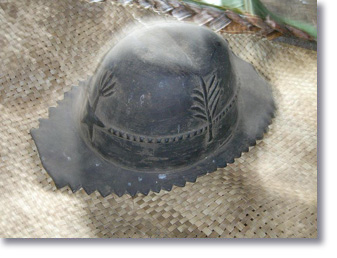 All the women
(including my new friend Valerie who was visiting Marakai for a few months
holiday from France) were dressed in Mal Mal (custom clothing). The women
were coming back from the gardens with baskets full of taro hung from
their heads for the evening meal. As soon as they dropped their huge baskets,
the women cut the heads off the taro which was fed to the pigs straight
away. The bush people of Marakai are not lazy people at all. They work
all day in their gardens which are some distance away from their village. All the women
(including my new friend Valerie who was visiting Marakai for a few months
holiday from France) were dressed in Mal Mal (custom clothing). The women
were coming back from the gardens with baskets full of taro hung from
their heads for the evening meal. As soon as they dropped their huge baskets,
the women cut the heads off the taro which was fed to the pigs straight
away. The bush people of Marakai are not lazy people at all. They work
all day in their gardens which are some distance away from their village.
Later, when
Chief Moli Sula and Assistant Chief Redion came back from their garden
work, the whole village sang "Nagariamel" for us. They used
to sing this special song when they lived with Jimmy Stevens who created
“Coconuts rebellion” before the 1980 Independence of Vanuatu
in Fanafo.
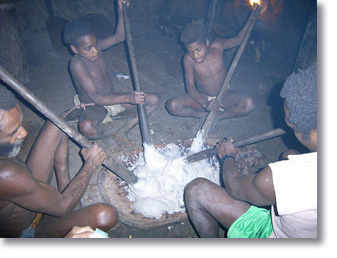
After singing, the villagers welcomed us with a Kava ceremony
and then we enjoyed the specially prepared kaikai "Nallot".
This form of laplap of taro is made using a Batutu (long wooden stick)
by 4 - 5 men on a big flat wooden platter. Yumi and I asked to join in
and help them and even for a few minutes, it was hard work for our muscles.
Later that evening, the
Chief showed us how to make a fire using special
wood with wooded stick. When it was time to sleep, the men slept in the
Nakamal, and Assistant Chief Redion showed Yumi and I to the guest bungalow
to sleep. He also slept in the same bungalow with us to protect us from
any bad spirits.
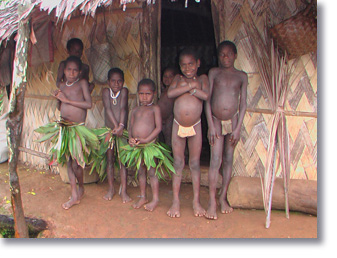 Day
3: We took lots of photographs of Marakai village and had a great
day spending time with bush people and their everyday life. Later in the
morning, after they sang us a farewell song, we departed the village.
Valerie walked with us for a while but then returned to the village. Day
3: We took lots of photographs of Marakai village and had a great
day spending time with bush people and their everyday life. Later in the
morning, after they sang us a farewell song, we departed the village.
Valerie walked with us for a while but then returned to the village.
Marakai
is a pure custom village. They don't use money and everything for living
is grown and taken from the bush environment, including salt which is
drained from water and ashes of the Black Palm tree. The men use the bark
of the Black Palm for their Mal Mal, and the women use the leaves of Nangaria.
Glen and Alexi had advised us that the people don't except money to stay
in their villages, so instead we took gifts of sugar, salt, candles, matches,
a lighter and other things in return for the hospitality we received at
every village.
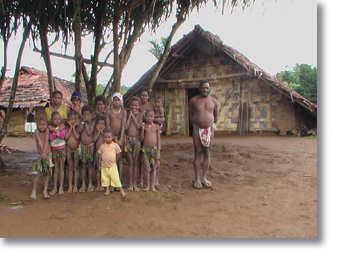
We arrived
at Taitaikara, the Dispensary (1,936 feet) at 2.00 pm. The Dispensary
was made by community from timber with and iron roof like normal house
with 2 big water tanks that had been carried in by volunteers from Luganville.
We had short break there, continued the hike passing Jaranatoa village
at 4.30 pm and arriving at Arvales (1,180 feet) just on dark at 6.00 pm.
It had been a very long and hard walking day. Unfortunately, the village
was suffering the death of a child, so we stayed in the guest house and
kept very quiet for the night. We were too tired to move anyway.
 Day
4: We passed the Malunpula River (1,260 feet) at 10.20 am and
the Makmakvuai River (1,350 feet) at 11.00 am to arrive at Tanmet village
(1,400 feet) at 1.15 pm. There we met Chief JonAu (who is Andy’s
father) and our friend Livo from Mavunlef village. They were very happy
to see us and the Chief really liked to storian (talking), we had good
conversation with him. I saw the girls playing a game called "stonem
leg" which was similar to dodge ball, again using a ball made of
leaves. Tanmet is also a custom village with everyone wearing Mal Mal,
including the Chief’s family. The villagers are Seven Day Adventist
and Yumi and I were recommended not to drink kava – that was for
men and boys only. It was quite incredible to find strong Christian faith
in such a remote custom village far from the town. Day
4: We passed the Malunpula River (1,260 feet) at 10.20 am and
the Makmakvuai River (1,350 feet) at 11.00 am to arrive at Tanmet village
(1,400 feet) at 1.15 pm. There we met Chief JonAu (who is Andy’s
father) and our friend Livo from Mavunlef village. They were very happy
to see us and the Chief really liked to storian (talking), we had good
conversation with him. I saw the girls playing a game called "stonem
leg" which was similar to dodge ball, again using a ball made of
leaves. Tanmet is also a custom village with everyone wearing Mal Mal,
including the Chief’s family. The villagers are Seven Day Adventist
and Yumi and I were recommended not to drink kava – that was for
men and boys only. It was quite incredible to find strong Christian faith
in such a remote custom village far from the town.
Day
5: The Chief and his wife Frora walked with us to the top of
the hill Tabuavaravu (1,875 feet) arriving at 10.30 am. We had a short
break and then continued our hike arriving at Moinpo (1,260 feet) at 3.30
pm. Finally, after 5 long and hard days of walking we arrived at our final
destination at Vunaspef village (650 feet) at 5.00 pm. This was Samuel's
home village and the starting place for the Millennium Cave tour. YEAH
!!! WE HAD MADE IT !!!
As soon as
we arrived, all the boys grabbed their guitars and wooden base and started
the singing. I had no idea how much energy they could muster. Samuel's
wife was expected our return so she had prepared huge kaikai of Bunyap
(taro, kumara, island cabbage and beef cooked in laplap style). We had
yet another Kava ceremony, played music, sang, ate and then everyone slept
around a fire in the same Nakamal.
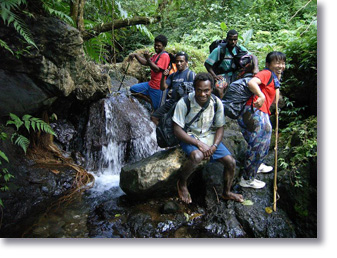
Day
6: I was fast sleep until many roosters start to crow outside the
Nakamal and everywhere else around the village around 4.30 am. It was
still dark, I was still exhausted and tried to sleep again, but couldn’t.
Then I heard the beautiful bird sounds and got up quietly to follow the
singing. There were huge bushes of bamboo all around the village and everything
was so peaceful. I sat down to listen to the birds and the bamboo for
a while … and then I heard the sound of the boys playing their guitars
again. What an awesome experience of tropical jungle, true custom villages
and the bush people of Espiritu Santo. Yumi and I heard so many interesting
custom stories and saw so much, it was a fantastic experience!!! We had
the best guides and company who have become good friends.
One of the
custom stories of South Santo is that if I were to ask a man for his sister's
name, he is not allowed to tell me. The same goes for asking a woman for
her brother’s name. Also, they cannot tell you their brother-in-law
or sister-in-law names, but they can write the names down. The reason
is respect for each other. It is a true story, ask anyone from South Santo.
Perhaps we will never understand some of their customs, but that should
not stop us respecting and letting people live their lives according to
their own custom.
|

